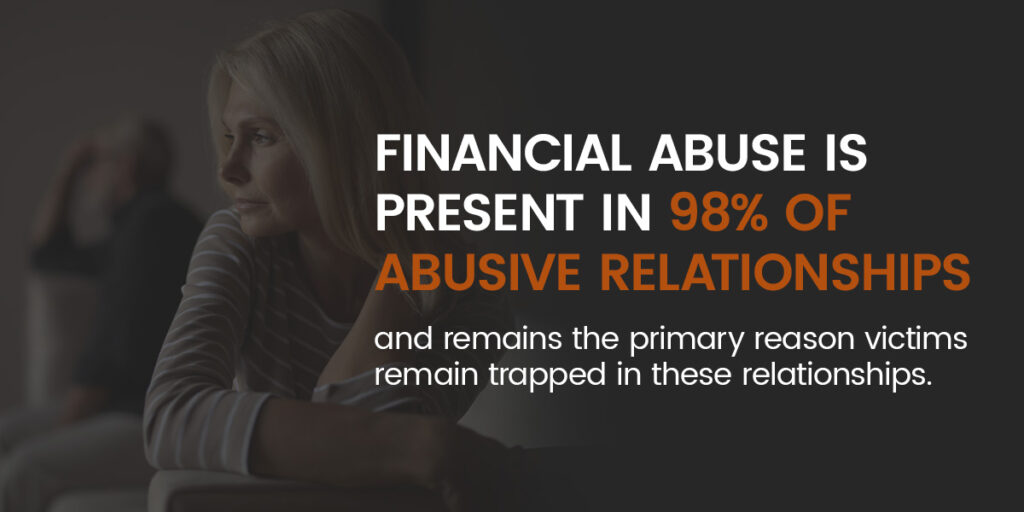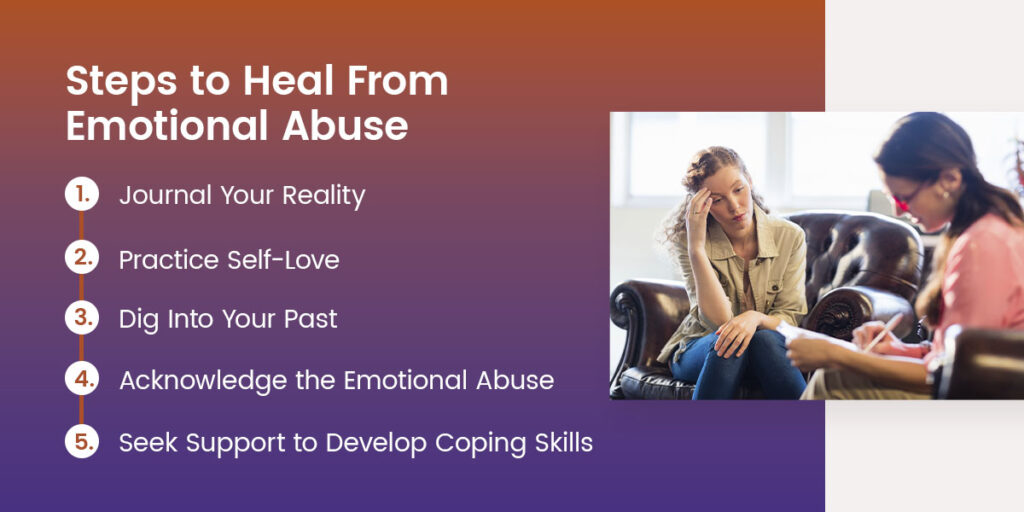How to Heal From Emotional Abuse
Unlike physical abuse, emotional abuse may not leave visible signs of harm like bruises and broken bones. Still, the impacts often leave survivors with deep and profound psychological wounds. These internal wounds can leave victims feeling powerless and alone.
The underlying goal of emotional abuse is to control, isolate and silence the victim. This complex form of abuse can be hard to recognize because its nature can be either insidious or overtly manipulative.
Here, we’ll discuss everything you need to know about emotional abuse in a relationship, the signs to look for and the steps to recovering from mental abuse.
What Is Emotional Abuse?
Emotional abuse involves an array of passive-aggressive, manipulative, controlling and mentally abusive behaviors. This form of abuse can occur in any kind of relationship — including friends, family members, romantic partners and even coworkers.
Whether emotional abuse is carried out in a subtle and covert or overt manner, victims often don’t realize that they are enduring abuse. It’s not uncommon for them to feel that the mistreatment is unintentional. The malicious message behind psychological torment attempts to convince the victim that their emotions and experiences are invalid, leading them to believe they are either overly sensitive or misinterpreting the behaviors.
These red flags define emotional abuse. Perpetrators may use one or more of these tactics to control and isolate their victims:
1. Verbal Abuse
Words are the weapons of emotional abusers. However, it’s not always easy to identify verbal abuse because behaviors like name-calling and shouting are often downplayed and excused. Abusers may use harsh critique and unfair judgment to chip away at the victim’s self-worth. Demeaning and degrading language may be used to embarrass and humiliate victims in public or private. The abuser may even spread rumors that damage the victim’s reputation.
Though many emotional abusers don’t physically harm their victims, they might use verbal threats to instill fear. Sometimes, perpetrators are calm and covert when using abusive language. Other times, they may scream and shout to create chaotic environments.
Another subtle and often hard-to-identify example of emotional abuse is exploited banter. While banter is essentially a playful exchange of teasing or mocking remarks, banter can become a form of bullying when used to humiliate, belittle and degrade the target intentionally, despite the target’s negative reaction. Often, emotionally abusive people hide behind the concept of banter to convince their victims that they are simply thin-skinned and too sensitive.
2. Gaslighting
The term “gaslighting” originates from the 1938 play titled “Gas Light.” The play entails the story of a manipulative man who convinces his wife that she has lost her mind. The husband intends to gain control of his wife to access her inheritance. He achieves this by dimming the gas lights in their home and insisting there has been no change in the lighting. Over time, he convinces his wife that she must be imagining the dimming lights. Eventually, she begins to doubt her own reality and sanity.
The term has since been used to describe a type of psychological manipulation that intends to undermine the victim’s understanding of their reality, experiences and surroundings. Gaslighting generally begins gradually as the perpetrator gains trust before subtly twisting the narrative to suit their ultimate goal.
Gaslighting tactics can question the victim’s memory. The perpetrator may aim to convince the victim that they misremember events or conversations. However, gaslighting can also fake conversations and events by tweaking narratives subtly and eventually blatantly.
3. Isolation
Emotionally abusive people often strive to isolate victims from family, friends and any sources of support. Abusers seek to isolate their victims to trap them. The abuser may try to convince the victim that certain friends and family are a bad influence or that they have ulterior motives. They may refuse to spend time with their victim’s loved ones with manipulative reasoning, like claiming that they are mistreated by their victim’s loved ones.
Abusers may use jealousy or instill guilt to isolate victims from their support system. This may play out in romantic relationships as baseless accusations of cheating or lying. In family and friend relationships, the victim may be accused of betrayal in a different form.
Over time, the victim may begin to mistrust their loved ones or avoid interactions to prevent chaotic responses from the abuser.
4. Coercive Control
Coercive control involves manipulation and intimidation to oppress and dominate. Abusers may use coercive control tactics to gain control of the victim’s finances. In this case, the abuser may start by questioning financial decisions, judging spending habits and eventually insisting on access to the victim’s finances. Financial abuse is present in 98% of abusive relationships and remains the primary reason victims remain trapped in these relationships.
The abuser may also monitor and track their victim’s activities throughout the day as a form of control. Monitoring efforts can include using GPS tracking and home surveillance systems or constantly calling or texting to confirm their victim’s whereabouts. Discouraging or mocking hobbies and interests and instilling guilt or shame for not devoting attention to them instead are other examples of coercive control.
The effects of coercive control tactics can cause victims to feel constantly watched and judged. They may feel that they have no privacy, as the abuser monitors and controls aspects of their daily lives.
5. Avoidant Abuse
Emotional withholding, the silent treatment and stonewalling are all ways that emotionally abusive people punish their victims. In these tactics, abusers refuse to communicate, dismiss or minimize concerns or refuse to respond entirely. These methods of avoidant abuse leave the victim feeling rejected, confused and frustrated. The effects of avoidant abuse may also further isolate the victim.
In some cases, avoidance can be a resort when people don’t know how to respond to a situation or cannot express their emotions. However, when the silent treatment is used as a means of punishment and control, avoidance becomes a form of abuse.
Understanding the Cycle of Emotional Abuse
Emotional abuse in a relationship does not always play out the same. However, the cycle of emotional abuse is often present. This devastating cycle has four stages:
1. Tension
A buildup of emotionally abusive behaviors defines the tension stage. During this stage, mistreatment may be subtle and gradual. Whether the abuser is using gaslighting, abusive language or means of coercive control, the victim may feel that the abuser is increasingly upset and that various aspects of the relationship are starting to worsen.
2. Incident
In physically abusive relationships, the stage of incidents involves physical violence. In emotionally abusive relationships, incidents can involve emotional withholding and other forms of avoidant abuse. When coercive control is an element, victims may find themselves cut off from their finances. While isolated from support systems, victims of emotional abuse may feel trapped and unable to find resolve.
3. Reconciliation
Following incidents, abusive individuals tend to seek reconciliation. In some cases, the abuser may apologize for their behavior. However, it’s key to understand that abusers hardly apologize and feel remorse but rather excuse their behaviors under the guise of an apology. Abusers may blame their actions on stress, unwavering care and concern for the victim or even blame the victim for the mistreatment.
4. Calm
Following reconciliation, there is usually a stage of calm. During this stage, the abuser tends to retreat from previously used forms of mistreatment to convince the victim that they are not abusive at all. This stage can be similar to the “honeymoon” stage in relationships, where abusers sometimes use love-bombing and other forms of coercion. Often, the tactics used in this stage aim to convince the victim that they are to blame for the incidents and mistreatment, which is a form of gaslighting.
Following this stage, the cycle of emotional abuse repeats. The cycle may eventually form a predictable pattern.
The Signs of Emotional Abuse
While it can be challenging to identify emotionally abusive tactics and behaviors, you may be able to spot these signs of abuse by evaluating yourself:
- Social withdrawal and isolation: You may start to avoid social situations and withdraw from friends and family in fear of abusive reactions. Social withdrawal can also occur as an attempt to prevent rousing concern from others. Feeling trapped and unable to reach your support system is a key sign of trauma from emotional abuse.
- Low self-esteem and self-blame: The effects of abusive language can degrade self-worth over time. You may also feel ashamed of who you are, whether through self-blame or the impact of abusive language and coercive control tactics.
- Fear of the abuser: Threatening language and the impacts of coercive control can instill fear and anxiety.
- Conforming to the abuser’s expectation: You may change your appearance, hobbies or interests to appease the abuser’s preferences and avoid abusive reactions.
- Dependence or codependence: Coercive control tactics aim to create dependence or codependence that can trap you in the relationship.
- Physiological impacts: Emotional abuse can lead to mental health conditions like depression and anxiety. You may notice changes in your sleeping and eating patterns due to depression, anxiety and stress.
These signs of abuse can impact victims to various degrees. The long-term effects of trauma from emotional abuse can lead to loss of sense of self and severe self-doubt. Psychological symptoms like depression and anxiety can become chronic, and the impacts of chronic psychological stress can lead to physical pain, insomnia, lethargy, impaired thinking and changes in appetite.
Steps to Heal From Emotional Abuse
While emotional abuse can occur alongside other forms of abuse, emotional abuse often occurs as an independent form of maltreatment. Despite the absence of violence in emotionally abusive relationships, a 2022 study of women involved with abusive partners found that psychological abuse is as damaging as forms of physical abuse. Moreover, a 2021 study of children with emotionally abusive parents found that psychological abuse was associated with more severe PTSD symptoms than other types of abuse.
The good news is that there is a path to recovering from emotional abuse.
1. Journal Your Reality
When coping with the effects of gaslighting and abusive language, your best means of defense is to uphold your grasp on reality. Make a habit of writing things down as you remember them. Following interactions with your abuser, grab a pen and jot down the encounter in as much detail as you can, from what was said to how you were feeling.
When gaslighting tactics emerge, you can refer to your journal to remind yourself that your memory is perfectly intact. Confirming your reality this way can help you avoid the impacts of gaslighting.
2. Practice Self-Love
Self-love becomes even more essential when abusers seek to undermine your worth through psychological torment. It’s not uncommon for victims to eventually feel worthless, crumbling at the effects of constant belittling, degrading and abusive language. The key to healing the psychological wounds left by harmful words is to replace them with affirming words of self-love.
Devote a separate journal to pen down positive messages for yourself. Whether you write down your strengths and talents or praise yourself for your accomplishments, each positive word can remind you of your worth. You can also practice self-love by repeating positive affirmations, devoting time to meditation and setting aside time to spoil yourself. These acts of self-love can help you heal.
3. Dig Into Your Past
The cycle of abuse can start in childhood. In some cases, childhood abuse can lead victims to fall into abusive relationships as adults, continuing the cycle of abuse and forging a pattern. When the cycle of abuse starts in childhood, you may find yourself falling into abusive relationships because they feel familiar.
Digging into your past will help you identify the start of the cycle. Whether it stems from childhood or adolescence or your experience is secluded, understanding your past can help you heal.
4. Acknowledge the Emotional Abuse
Acknowledging your experience is another key to healing. It may take time to accept the whole truth of your experience, as many victims of abuse move through stages of denial, anger, guilt and shame. However, these motions are vital to recovering from mental abuse.
5. Seek Support to Develop Coping Skills
Breaking the cycle of abuse can be challenging, even if your cycle is secluded to one relationship. Often, the path to recovering from emotional abuse requires external support. Beyond building self-awareness and taking back your worth, you may benefit from cognitive behavioral therapy (CBT).
CBT is a type of therapy that can help change behavioral and thought patterns. A CBT therapist can help you identify the root of an abusive cycle and develop healthy coping strategies to exit these relationships safely. With modified thought patterns, you can more easily avoid abusive relationships in the future.
The Sanctuary at Sedona offers two forms of CBT therapy — pure cognitive therapy, which focuses on reprogramming thought patterns, and rational emotive therapy (RET), which focuses on altering negative emotions.
Start Healing From Emotional Abuse at The Sanctuary at Sedona
The Sanctuary at Sedona offers victims of abuse a chance at recovery. We provide several holistic therapies ranging from CBT and energy medicine therapy to depth psychology methods that aim to induce healing at a core level. Our comprehensive residential treatment programs are designed to treat trauma and abuse by resolving root causes through science-based techniques.
Healing from emotional abuse can take time, but with the right support, survivors of abuse can reclaim their lives and mend psychological wounds. Speak with a counselor today to start your healing journey and recover from the impacts of psychological abuse.





